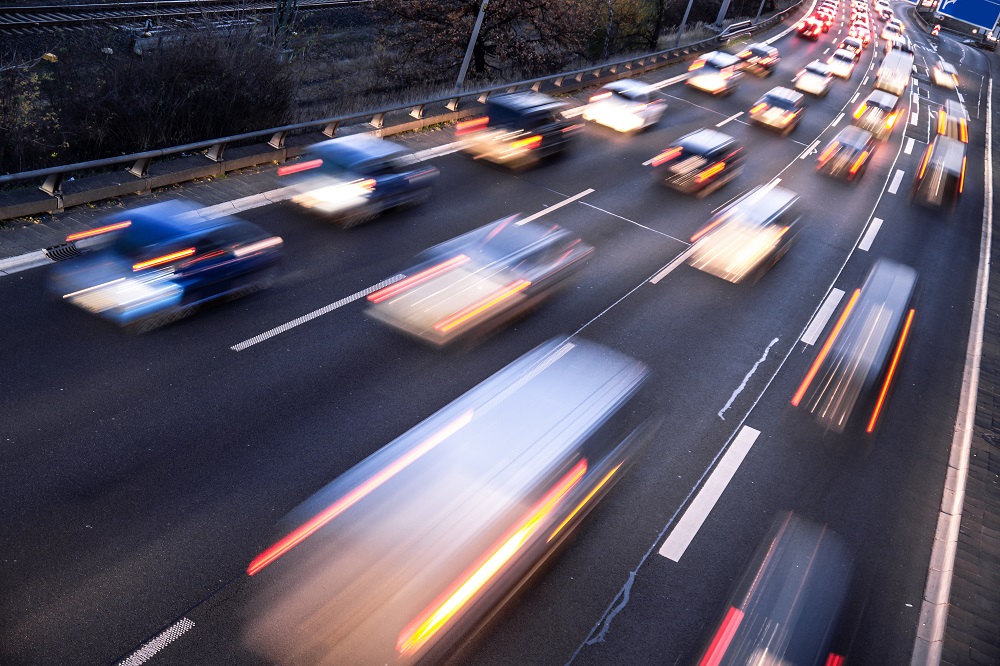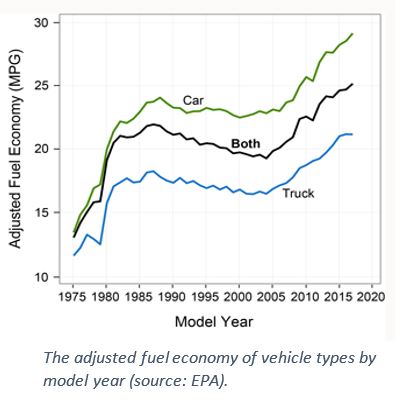Corporate Average Fuel Economy (CAFE) Standards

Corporate Average Fuel Economy (CAFE) Standards
Benefits, Past and Future
The CAFE standards and related vehicle emissions standards governing the efficiency of passenger cars, trucks, and other vehicles, have delivered tremendous benefits for consumers, U.S. energy security and competitiveness, and the environment. Called “one of the most impressive efficiency successes in modern memory” by the National Academy of Sciences, the benefits take many forms:
- Saving consumers money: Consumers primarily realize fuel economy benefits at the pump – but not only. It may cost a little extra to make a more efficient vehicle, but savings pile up over the lifetime of vehicle ownership. Customers save money on fuel, and the standards provide the consistency and clarity that drives innovation, making better vehicles more affordable. Projections based on the previous Phase 2 standards predicted model year 2025 customers would have received roughly $8,200 in net savings over the life of a vehicle, adding up to $1.7 trillion nationwide. Buyers of all-new 2017 vehicles are expected to save more than they spend 94% of the time. One-quarter of “all-new” 2017 vehicles achieved greater fuel economy and cost less than their 2011 counterparts. Economic analysis also finds low-income consumers benefit the most from such programs.
- Strengthening U.S. energy security: A key objective of their original passage, CAFE standards reduce U.S. reliance on imported oil. Estimates from the University of Tennessee find fuel economy improvements to cars and light trucks enacted since 1975 have avoided the use of 1.5 trillion gallons of gasoline, enough to drive all the cars and light trucks in the U.S. for over ten years (based on a 2015 rate of consumption).
- Protecting the environment: Fuel economy standards are among the most powerful policies to reduce carbon emissions and other pollution. The EPA’s original vehicle emission standards for model years (MY) 2012-2025 light-duty vehicles, for example, were projected to cut GHG emissions by 6 billion metric tons over the lifetime of the vehicles. The Economist magazine estimated that these same vehicle emissions and fuel economy standards – alone – would constitute the 6th largest cause of global greenhouse gas (GHG) emissions reductions. It shares the “top six” designation with high-impact policies such as the Montreal protocol; worldwide hydro, nuclear, and renewable power deployments; and China’s one-child policy.
- Enhancing U.S. competitiveness: Research has shown that CAFE standards drive innovation and help U.S. companies compete in international markets, especially in an era of low oil prices. Innovative vehicle manufacturers have a first-mover advantage, in which their leadership helps them achieve greater economies of scale, and benefit from leaps forward in technological learning. It also speeds the maturity of key technologies. For example, the market share for direct injection fuel systems – a key fuel economy technology – went from zero in 2007 to 46% in 2015, with similar trends in gasoline turbochargers, cylinder deactivation, engine stop/start systems, and variable valve timing. Recognizing their advantages, other countries around the world are moving assertively to enhance their own fuel economy standards: Japan, South Korea, the EU, India, and China have established standards and targets that will surpass U.S. standards between 2015 and 2020.
History of CAFE Standards
The energy crisis of 1973 exposed dangerous economic and national security vulnerabilities resulting from our dependence on imported oil, prompting Congress to take action. The CAFE standards were passed in 1975 as part of the Energy Policy and Conservation Act, setting a requirement for manufacturers to produce a fleet of vehicles that reached a specific average fuel economy. This structure – covering a fleet instead of a more prescriptive standard for each vehicle – gave manufacturers flexibility in meeting the standards while accomplishing the goal of improved efficiency. Fuel economy roughly doubled from a fleetwide average of 13.4 mpg in 1973 to 27.5 mpg ten years later. However, as American consumers developed a taste for larger vehicles, the standards were relaxed to 26 mpg for passenger vehicles, and stagnated for a full two decades (Figure 1). In 2007, Congress passed the Energy Independence and Security Act (EISA), which shifted the “one-size-fits-all” standards for cars and trucks to “attribute-based” standards for cars based on vehicle size and boosted federal agencies’ authorities and responsibilities. This included requiring the National Highway Traffic Safety Administration (NHTSA) to set standards for vehicle fuel efficiency every year and for the Environmental Protection Agency (EPA) to establish parallel GHG emissions standards for vehicles. As a result, CAFE standards for light duty vehicles rose by roughly 40%, to 35 mpg by 2020.
 In a political breakthrough to overcome the start-stop nature of standard-setting, an agreement between the federal government, state regulators, and the automobile industry was achieved in 2009 to implement a National Program to develop a forward-looking strategy implementing fuel efficiency standards over the next 30 years. The Program includes NHTSA (to set fuel economy standards) and the EPA (to set emissions standards), as well as the California Air Resources Board (CARB), as the Clean Air Act provided the State of California with the unique authority to set vehicle standards that are more stringent than federal standards. Standards established in 2012 required fleet averages for passenger cars to reach 34.1 miles per gallon (mpg) by MY2016, and to 54.5 mpg by MY 2025. However, on April 2, 2018, the Trump Administration ruled that the standards covering the 2022-2025 timeframe were “not appropriate and should be revised,” opening up the possibility of severely weakening the standards going forward.
In a political breakthrough to overcome the start-stop nature of standard-setting, an agreement between the federal government, state regulators, and the automobile industry was achieved in 2009 to implement a National Program to develop a forward-looking strategy implementing fuel efficiency standards over the next 30 years. The Program includes NHTSA (to set fuel economy standards) and the EPA (to set emissions standards), as well as the California Air Resources Board (CARB), as the Clean Air Act provided the State of California with the unique authority to set vehicle standards that are more stringent than federal standards. Standards established in 2012 required fleet averages for passenger cars to reach 34.1 miles per gallon (mpg) by MY2016, and to 54.5 mpg by MY 2025. However, on April 2, 2018, the Trump Administration ruled that the standards covering the 2022-2025 timeframe were “not appropriate and should be revised,” opening up the possibility of severely weakening the standards going forward.
At the Crossroads
Fuel economy and emissions standards for vehicles bring greater innovation, a stronger economy and competitiveness, a cleaner environment, and a safer sector, and they work best when they provide a consistent and clear path into the future. Weakening the standards will saddle U.S. consumers with more costs and greater vulnerability to unstable fuel prices, hurt U.S. competitiveness abroad, and potentially divide the U.S. market into a patchwork of uneven regulations, sowing confusion for consumers and automakers alike. The choice is clear.
STAY EMPOWERED
Help the Alliance advocate for policies to use energy more efficiently – supporting job creation, reduced emissions, and lower costs. Contact your member of Congress.
Energy efficiency is smart, nonpartisan, and practical. So are we. Our strength comes from an unparalleled group of Alliance Associates working collaboratively under the Alliance umbrella to pave the way for energy efficiency gains.
The power of efficiency is in your hands. Supporting the Alliance means supporting a vision for using energy more productively to achieve economic growth, a cleaner environment, and greater energy security, affordability, and reliability.



